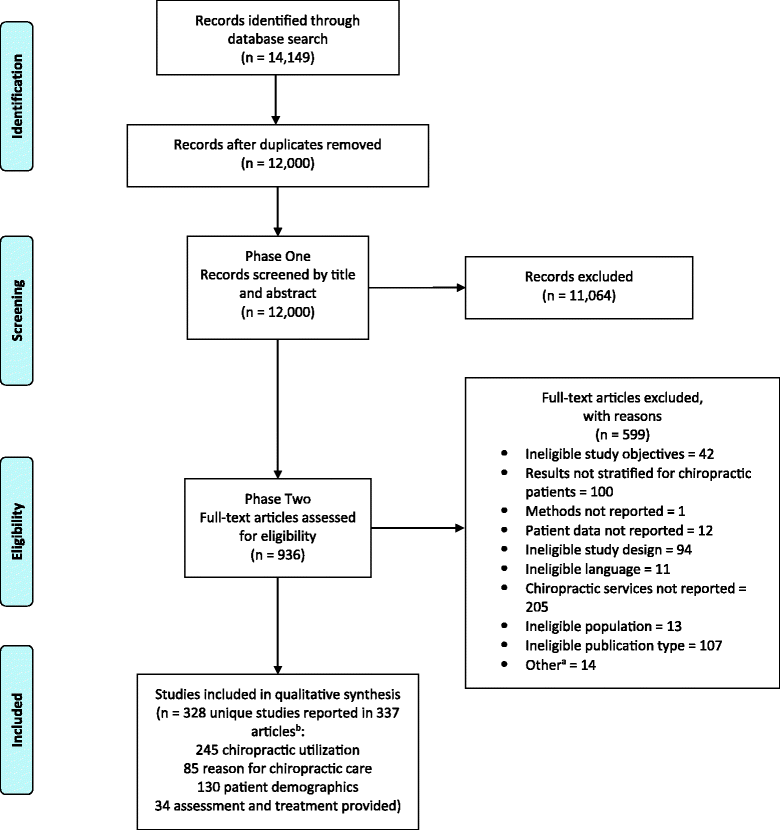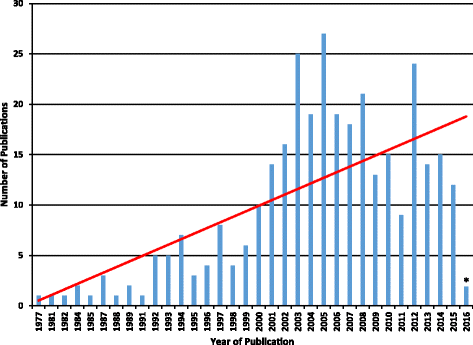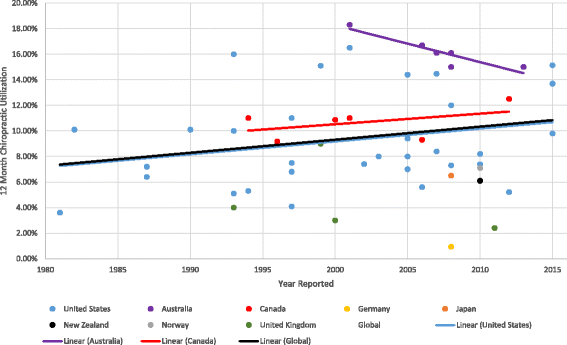The chiropractic profession: a scoping review of utilization rates, reasons for seeking care, patient profiles, and care provided
- PMID: 29201346
- PMCID: PMC5698931
- DOI: 10.1186/s12998-017-0165-8
The chiropractic profession: a scoping review of utilization rates, reasons for seeking care, patient profiles, and care provided
Abstract
Background: Previous research has investigated utilization rates, who sees chiropractors, for what reasons, and the type of care that chiropractors provide. However, these studies have not been comprehensively synthesized. We aimed to give a global overview by summarizing the current literature on the utilization of chiropractic services, reasons for seeking care, patient profiles, and assessment and treatment provided.
Methods: Systematic searches were conducted in MEDLINE, CINAHL, and Index to Chiropractic Literature using keywords and subject headings (MeSH or ChiroSH terms) from database inception to January 2016. Eligible studies: 1) were published in English or French; 2) were case series, descriptive, cross-sectional, or cohort studies; 3) described patients receiving chiropractic services; and 4) reported on the following theme(s): utilization rates of chiropractic services; reasons for attending chiropractic care; profiles of chiropractic patients; or, types of chiropractic services provided. Paired reviewers independently screened all citations and data were extracted from eligible studies. We provided descriptive numerical analysis, e.g. identifying the median rate and interquartile range (e.g., chiropractic utilization rate) stratified by study population or condition.
Results: The literature search retrieved 14,149 articles; 328 studies (reported in 337 articles) were relevant and reported on chiropractic utilization (245 studies), reason for attending chiropractic care (85 studies), patient demographics (130 studies), and assessment and treatment provided (34 studies). Globally, the median 12-month utilization of chiropractic services was 9.1% (interquartile range (IQR): 6.7%-13.1%) and remained stable between 1980 and 2015. Most patients consulting chiropractors were female (57.0%, IQR: 53.2%-60.0%) with a median age of 43.4 years (IQR: 39.6-48.0), and were employed (median: 77.3%, IQR: 70.3%-85.0%). The most common reported reasons for people attending chiropractic care were (median) low back pain (49.7%, IQR: 43.0%-60.2%), neck pain (22.5%, IQR: 16.3%-24.5%), and extremity problems (10.0%, IQR: 4.3%-22.0%). The most common treatment provided by chiropractors included (median) spinal manipulation (79.3%, IQR: 55.4%-91.3%), soft-tissue therapy (35.1%, IQR: 16.5%-52.0%), and formal patient education (31.3%, IQR: 22.6%-65.0%).
Conclusions: This comprehensive overview on the world-wide state of the chiropractic profession documented trends in the literature over the last four decades. The findings support the diverse nature of chiropractic practice, although common trends emerged.
Keywords: Chiropractic; assessment; patient demographics; scoping review; statistics; treatment; utilization.
Conflict of interest statement
Ethics approval and consent to participate
Not applicable
Consent for publication
The authors of this publication have each given consent for publication.
Competing interests
PJHB, AEB, SAM and SDF have received research funding from the Canadian national and provincial chiropractic organizations, either as salary support or for research project funding. JJW received research project funding from the Ontario Chiropractic Association, outside the submitted work. SDF is Deputy Editor-in-Chief for Chiropractic and Manual Therapies; however, he did not have any involvement in the editorial process for this manuscript and was blinded from the editorial system for this paper from submission to decision.
Publisher’s Note
Springer Nature remains neutral with regard to jurisdictional claims in published maps and institutional affiliations.
Figures



Similar articles
-
Understanding patient profiles and characteristics of current chiropractic practice: a cross-sectional Ontario Chiropractic Observation and Analysis STudy (O-COAST).BMJ Open. 2019 Aug 26;9(8):e029851. doi: 10.1136/bmjopen-2019-029851. BMJ Open. 2019. PMID: 31455707 Free PMC article.
-
Disparities in chiropractic utilization by race, ethnicity and socioeconomic status: A scoping review of the literature.J Integr Med. 2023 Mar;21(2):159-167. doi: 10.1016/j.joim.2023.02.002. Epub 2023 Feb 17. J Integr Med. 2023. PMID: 36841750
-
Patients using chiropractors in North America: who are they, and why are they in chiropractic care?Spine (Phila Pa 1976). 2002 Feb 1;27(3):291-6; discussion 297-8. doi: 10.1097/00007632-200202010-00018. Spine (Phila Pa 1976). 2002. PMID: 11805694
-
Measuring the Appropriateness of Spinal Manipulation for Chronic Low Back and Chronic Neck Pain in Chiropractic Patients.Spine (Phila Pa 1976). 2021 Oct 1;46(19):1344-1353. doi: 10.1097/BRS.0000000000004009. Spine (Phila Pa 1976). 2021. PMID: 34517404 Free PMC article.
-
Chiropractic services in the active duty military setting: a scoping review.Chiropr Man Therap. 2019 Jul 15;27:45. doi: 10.1186/s12998-019-0259-6. eCollection 2019. Chiropr Man Therap. 2019. PMID: 31338157 Free PMC article.
Cited by
-
Chiropractic Management of Neck Pain Complicated by Symptomatic Vertebral Artery Stenosis and Dizziness.Am J Case Rep. 2022 Oct 19;23:e937991. doi: 10.12659/AJCR.937991. Am J Case Rep. 2022. PMID: 36258651 Free PMC article.
-
Segmental Chiropractic Spinal Manipulation Does not Reduce Pain Amplification and the Associated Pain-Related Brain Activity in a Capsaicin-Heat Pain Model.Front Pain Res (Lausanne). 2021 Nov 1;2:733727. doi: 10.3389/fpain.2021.733727. eCollection 2021. Front Pain Res (Lausanne). 2021. PMID: 35295444 Free PMC article.
-
Chiropractic Spinal Manipulation Prevents Secondary Hyperalgesia Induced by Topical Capsaicin in Healthy Individuals.Front Pain Res (Lausanne). 2021 Jul 20;2:702429. doi: 10.3389/fpain.2021.702429. eCollection 2021. Front Pain Res (Lausanne). 2021. PMID: 35295504 Free PMC article.
-
Improvement of Chronic Neck Pain After Posterior Atlantoaxial Surgical Fusion via Multimodal Chiropractic Care: A Case Report.Cureus. 2023 Feb 4;15(2):e34630. doi: 10.7759/cureus.34630. eCollection 2023 Feb. Cureus. 2023. PMID: 36891015 Free PMC article.
-
Understanding patient profiles and characteristics of current chiropractic practice: a cross-sectional Ontario Chiropractic Observation and Analysis STudy (O-COAST).BMJ Open. 2019 Aug 26;9(8):e029851. doi: 10.1136/bmjopen-2019-029851. BMJ Open. 2019. PMID: 31455707 Free PMC article.
References
-
- World Federation of Chiropractic: The Current Status of the Chiropractic Profession: Report to the World Health Organization from the World Federation of Chiropractic. 2012.
-
- Lester M. Chiropractic : An Introduction. 2012.
-
- Alliance CAMDOC. The Regulatory Status of Complementary and Alternative Medicine for Medical Doctors in Europe. 2010.
Publication types
MeSH terms
LinkOut - more resources
Full Text Sources
Other Literature Sources
Medical

